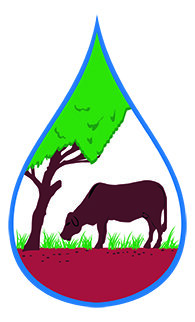Field Day at Worona Station
On Friday the 11th September 2020, the Dalrymple Landcare Committee held a field day at ‘Worona’ Station, hosted by Chris and Theresa LeFeurve. Chris and Theresa have been using a method of land rehydration to improve the drought resilience and productivity of their 6677 hectare property.
They’ve partnered with the Mullon Institute and NQ Dry Tropics to undertake further works to achieve their long term plans for rehydration and regeneration across the whole of the property, whilst sharing their actions and results to other graziers in the region. The aim is to restore the creeks and floodplains as close as possible to their original state and function. When you have healthy creeks, you store water in the adjoining landscape, providing critical soil moisture for flora and fauna to thrive, and building resilience for extreme weather conditions.
Chris and Theresa use rotational grazing within their beef enterprise. Cattle graze an area anywhere from a few hours a day to a whole day, depending on the size of the paddock and the number of cattle in that area. Generally large mobs of cattle are moved daily. Paddocks get grazed twice in 365 days. Chris uses single wire electric fence and runs the wire from tree to tree instead of using steel posts. Training cattle to get used to the single wire fence was relatively easy, by starting it in the yards and gradually moving the wire further and further away from the yard rails each day. The cattle get super quiet as they get handled daily. Chris talked about cattle being patch grazers and a grass type might get left the first grazing but will get cleaned up at the second graze.
At ‘Worona’ the focus is on kilos of beef/hectare rather than individual weight gain and even though individuals sometimes do not do as well as others, because there are so many of them, there is more beef produced. Chris states that the cattle need to work for you – as soon as you start spending money on them (lick and hay) you’re working for them.
Chris relies on ‘today’s energy’ – the sun and doesn’t like using ancient energy- duch as diesel in machines. The sun provides the energy that grass needs to grow. Leaf matter on the ground is blocking the sun from getting into the soil and is therefore stopping the energy cycle. For the first time Chris is trialling the use of goats to clean up leaf litter etc on the ground plus strip berry bush and other weeds to let the sunlight into the soil and to put them back through the system via manure.
The LeFeurve’s are not worried about weeds and believes the cows will sort them out and that they are a sign that something is wrong with the soil and the weeds are trying to fix it. Chris quotes that “Whatever you focus on, you get more of” …..so he concentrates on growing grass instead of killing weeds.
Chris is always keeping an eye on the landscape for where wash-aways could potentially start. A series of earthworks creating levy banks and small dams to divert water has been done and paid for by NQDT but Chris says upfront that due to costs and risk of doing further damage, he would rather use cattle. He prefers to use cattle to bust up soil and knock down edges of breakaways instead of machinery.
Thanks to Dianne Hood, DLC Chairperson for contributing this article.



